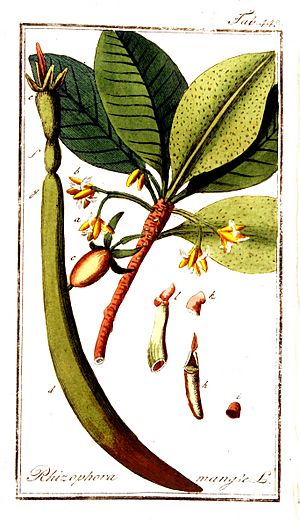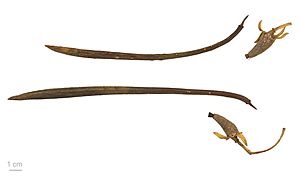Red mangrove facts for kids
Quick facts for kids Red mangrove |
|
|---|---|
 |
|
| An old drawing from 1796 by Johannes Zorn | |
| Conservation status | |
| Scientific classification | |
| Genus: |
Rhizophora
|
| Species: |
mangle
|
The red mangrove (Rhizophora mangle) is a special tree found in coastal areas around the world where fresh and salt water mix. Its "seeds" are quite unique! They are actually tiny, living plants called propagules that start growing while still attached to the parent tree. These young plants then drop into the water and float away until they find a shallow, muddy spot to grow.
Red mangroves are easy to spot because of their amazing prop roots. These roots arch out from the trunk and grow down into the water, making the tree look like it's standing on stilts. This gives the red mangrove its classic "mangrove" look. These trees are super important for coastal areas in places like Florida, Louisiana, and Texas. They provide homes for many animals. However, in some places like Hawaii, red mangroves can grow too much and take over, becoming an invasive species. Even so, these thick mangrove forests are great places for fish, birds, and even crocodiles to live and hunt.
Contents
Where Red Mangroves Live
Red mangroves grow in warm, wet places called subtropical and tropical regions around the world. You can find them along coastlines in brackish water, which is a mix of fresh and salt water, and in swampy salt marshes. They are very good at living in salty water where most other plants can't survive. Because of this, they create their own special ecosystems called mangals.
Red mangroves often grow near other types of mangroves, like white mangroves (Laguncularia racemosa), black mangroves (Avicennia germinans), and buttonwood (Conocarpus erectus). By holding the soil in place with their roots, mangroves help create a safe home for many other plants and animals, such as mangrove crabs. Even though their roots are in the soil, they are often covered by water for many hours or even all the time. The roots usually grow in sand or clay, which helps protect them from strong waves.
What Red Mangroves Look Like
You can easily tell a red mangrove apart from other trees by its special prop roots and its unique living "seeds" (propagules). The prop roots lift the tree above the water, giving it extra support and protection. These roots also help the tree breathe! They allow the tree to take in oxygen directly from the air, which is important because the soil they grow in often has very little oxygen.
A red mangrove tree can grow as tall as 24 meters (80 feet) in perfect conditions, but they are usually about 6 meters (20 feet) tall. Their bark is thick and has a grey-brown color. The leaves of a red mangrove are about 2.5 to 5 centimeters (1 to 2 inches) wide and 7.5 to 12.5 centimeters (3 to 5 inches) long. They have smooth edges and an oval shape. The top side of the leaves is a darker green than the bottom side. In the spring, the tree produces small yellow flowers.
Red Mangrove Life Cycle and Reproduction
Red mangroves are special because they are viviparous plants. This means their "seeds" (propagules) start growing into a living plant while still attached to the parent tree. These propagules look like long, skinny pods. When they are fully grown, they are ready to root and become a new tree as soon as they drop off.
Red mangrove trees are also hermaphrodites, which means each tree has both male and female parts. They can pollinate themselves, or their pollen can be carried by the wind to other trees. The young propagule does not have a resting stage like a normal seed. Instead, it keeps growing until it's a small, live plant before it leaves its parent. A mangrove propagule can float in the salty water for more than a year before it finds a good spot to root and start growing into a new tree.
Images for kids
-
A red mangrove tree growing in shallow water in Everglades National Park
-
A red mangrove forest in Fajardo, Puerto Rico
-
An ecotourist on a kayak tunnels through red mangrove trees and roots at Lido Key








